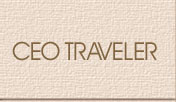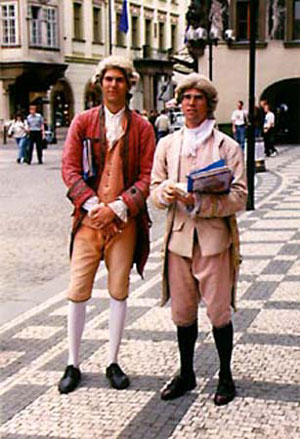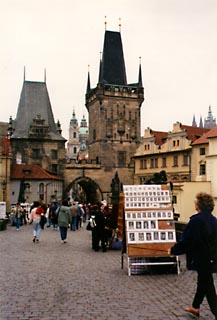 |
|
|
|
|
|
|
|
|
|
|
|
|
|
|
|
|
|
|
|
|
|
|
|
|
|
|
 |
 |
|
|
|
|
|
|
|
|
|
|
|
|

|
Prague
The Golden City In Prague's Old Town Square a young man hands me a paper from the stack he's holding. A witty spoof, it is blank. Throughout the city from light until dark, twenty-somethings distribute fliers announcing ballet, plays, musicals, laterna magika, rock and jazz concerts, folkloric ensembles, black light theater (a Czech genre) and opera. Some, who publicize chamber music, wear period garb from Mozart's time. Others don multicolored velvet hats like the ones worn by jesters in the Middle Ages. They celebrate the mirth and music of a town that has been laughing and singing since the Velvet Revolution of 1989 ended Communist domination.Prague, which blossomed under Charles IV, Rudolf II and T.G. Masaryk, seems to be undergoing another golden age and a rekindling of la vie boheme. It is now a movable party. That very same day, the Danish Police Band, who was in the "Mother of Cities" by government invitation, gave a lively recital in the shadow of the square's monument to Jan Hus. The next morning a five-piece jazz band entertained in the plaza and large inflatable jumping bags were placed over the bricks for frolicking children to bounce on. Prague also bears the sobriquet "Golden City" because its more than 500 spires appear to be the color of gold as they sparkle in the sunlight. Millions of visitors from all over the world pour into what is the heart of Europe for the Czech Republic borders on Germany, Austria, Poland and Slovakia. Officially 10,000 Americans, who came here to teach English after 1989, live in the metropolis, but an off-the-record count is closer to 30,000.
With a populace of only 1,200,000, Prague is smaller than most European capitals and although sophisticated, the atmosphere of a small town still emerges now and then. At an outdoor cafe on the cobbled sidewalk of Parizska Street, passersby stop to chat with the patrons. Horses clip-clop as they draw carriages up the thoroughfare. The occupants are, of course, sightseers, but in the mind's eye, they could have been residents taking a ride decades ago. The metropolis is spread out. However, it is easily explored since the important central areas are imminently walkable and not far from the Vltava (Moldau) River, which curves through town like an arc and is spanned by 18 bridges. Mala Strana (Little Quarter) and Hradcany (the site of the castle) are on the left side of the water and on the right are Stare Mesto (Old Town), Nove Mesto (New Town founded in the 14th century) and Josefov, the former Jewish ghetto. Climb to the top of the four-sided clock tower in the Old Town Hall in Old Town Square for a panoramic view of the districts. Cars are banned from the square as they are from some of the other main streets and plazas. Radiating from Old Town Square are paths that lead to Republic Square, Wenceslas Square, a sprawling commercial boulevard, and the Charles Bridge, a gathering place crowded with 30 intricate Baroque statues. The earliest written document about the city was penned in 965 by a Jewish merchant from Portugal, Ibrahim Ibn Jacob, who described a town of "stone and lime." Street plans laid out and homes built during medieval times are, more or less, still in place today. Nothing can be changed in the historic corner as UNESCO has listed it as a World Heritage site. Granite, slate and sandstone were the predominant building materials. Within the ancient perimeter, structures are usually no more than four stories tall. Stucco-covered houses painted in quiet shades of lime, pink and beige with contrasting moldings, often white, have peaked fluted tile roofs. Facades covered with sgraffiti illustrate the artistry of this Renaissance technique. Patterns chipped into the surface plaster uncover a second layer and create an embossed two-color effect. Heavy wrought iron streetlights perfect Prague's centuries-old appearance. Franz Kafka, a man who enjoyed little fame and satisfaction as a resident of Prague, has finally been discovered by the citizenry and his ghost pervades Stare Mesto. Visitors flock to the house in Hradcany's Golden Lane, street of the alchemists, where Kafka wrote short stories. One of the newest attractions--it opened in summer, 1998--"The St. Michael Mystery," an emotional journey made up of 14 bizarre magical scenes, portrays Prague through Kafka's eyes. Staged in an 800-year-old reconstructed monument, the presentation also makes use of film, photographs, paintings and artifacts to review the city's history. The exhibit (Michalska St. 27-29, Prague 1-Old Town, tel. 2421 2716) is best seen on your first day as the material presented will enrich your stay. A half-day tour, to get your bearings and before any earnest sightseeing begins, is always recommended. Unfortunately, we chose Prague Sightseeing's three and one-half hour Grand City Tour, which began chaotically in Republic Square where a half dozen buses were parked. The lateness of some of the guides and the disorganization led to a delay in getting started. There are a few other smaller companies, but Prague Sightseeing seems to get most of the business. Perhaps Martin Tours is a better option.
Katja pointed out the giant metronome, up on the hill near the funicular, which replaced the larger-than-life statue of Stalin. The head is now part of one of the grim displays in St. Michael's Mystery. Most visitors take a short cruise on the Vltava. Our one-hour trip was with EUD, whose boats depart hourly, 10 a.m. to 6 p.m., from a dock near the Inter-Continental. Tourists taxi it all over town, but we think it is adventurous to try public transportation, which is an efficient system of buses, trams and metros and is easy to use. Taxis are notorious for overcharging. Ask the driver for an estimate before getting in and make certain that the meter shows the digit "1" next to the fare. For an effortless day trip outside the city, visit Karlstejn to view the fairy-tale castle built in the 14th century by Emperor Charles IV. The train leaves from the main station once every hour and takes about 45 minutes. Want to let the folks back home know what an exciting time you are having in Prague? Don't wait for snail mail to reach them, but bring e-mail addresses and go to the Cyber Cafe, next to the Municipal Building. For about $1.30 for 10 minutes you can tell everyone more about your trip than you could if you used the post office. WHERE TO STAY The location of the Inter-Continental, within walking distance of the major city sites, is the best in Prague. Perhaps it was because the Communists showed no concern for the architectural harmony of the surrounding buildings in the historic Josefev section, but the outside of the 25-year-old hotel is very modern and may disappoint. Any dissatisfaction, though, will fade once you are inside the doors.The hotel is decorated with a fine collection of rare artwork and antiques and recently underwent a complete renovation to create sumptuous public spaces and very comfortable guest rooms. Service is superb. The work ethic in the former regime was largely, "We pretend to work and you pretend to pay us." A decade is not a long time to eradicate the remnants of a totalitarian system, but Inter-Continental is run as well as any five-star establishment catering to discriminating guests. The well-staffed concierge desk handled personal requests, booked tickets and answered questions promptly and cheerfully. The new health club includes a very large swimming pool, a golf putting green and an aerobics studio where four fitness classes are held each day. Hotel-Intercontinental Praha, Nam. Curieovych 43/5, 110 00 Prague 1, Czech Republic. Tel. 800-327-0200, 42-2-2488-1111. Rates start at $310 and include an excellent buffet breakfast. www.prague.intercontinental.com WHERE TO DINE The Relais & Chateaux group is like an exclusive private club. Standards for inclusion are high and there are only two members in Eastern Europe. One is the eponymous hotel owned by Martin Hoffmeister. Two hundred of the works of his father, Adolf, hang on the walls. Among them are sketches of the great personalities of the world, who were friends of the artist in the first half of the century, and include Shaw, Giacometti, Picasso and Joyce.The handsome decor of the hotel's dining room, Restaurant Ada, is contemporary, with a bow to Czech design in the form of sparkling chandeliers and a lighted case filled with exquisite crystal. It was here that we were introduced to Beckerovka, a delightful herb aperitif made in Karlsbad, which became our pre-dinner drink throughout our stay. If you think that the national cuisine is always heavy, think again. At Ada traditional dishes have been lightened to appeal to today's tastes. Two sprightly salads, one with melted goat cheese and the other with salmon carpaccio were fine starters. The menu makes uses of fresh farm products like duck and rabbit. Medallions of rabbit were lean and tender. Breast of duck with caraway seeds, potato-sauerkraut hash, savoy cabbage and potato pancakes, though by no means a spa meal, have been refashioned into subtler versions of those dishes the special dessert of the house is strawberry dumplings, which were so favored by Martin Hoffmeister when he was a child that he frequently ate them instead of dinner. And if Mr. Hoffmeister has time, particularly if you are a hotel guest, perhaps you might get him to talk about his interesting parents. His mother was an actress and his father a diplomat and writer, as well as a caricaturist. Martin Hoffmeister himself is no slouch when it comes to accomplishments. Not only does he run a superior hotel and restaurant, but he is a filmmaker, too. Restaurant Ada, Hotel Hoffmeister, Pod Bruska 7, Klarov, 118 00 Prague 1. Tel. 420-2-5731-0942. Open seven days, lunch and dinner. Expensive. www.hoffmeister.cz/en/ada.html At Restaurant Hradcany when the weather permits, a push of a button opens the atrium, the glass sinks into the floor and the unobstructed sky becomes part of the backdrop. Even with the windows shut, the view up--the ceiling is festooned with greenery--is engaging. Although the room is traditional with Belle Epoque sconces, burgundy brocade panels and a gallery of oil paintings, there is no clash between the formal design and the gardenlike touches. In the style of the town's best restaurants, there is live music at dinner. Tables are set far apart and sometimes the center of the floor is cleared for dancing. Located in the Hotel Savoy, a small, luxurious Art Noveau building, the restaurant adjoins the English-style Aperitif Bar where you might begin your evening with a glass of Beckerovka before proceeding to the dining room. The chef creates a new four-course market-fresh menu daily using seasonal products. The imaginative selections of cold and hot appetizers included saddle of venison and sheep cheese terrine. Main courses--roast veal in potato and ham crsut, asplash with chervil sauce, and breast of guinea hen finished with champ sauce and accompanied by corn meal cakes--again affirmed that Eastern European food does not have to be leaden. Side dishes of red and savoy cabbages showed that earthy foods when properly cooked can be sublime. Service is Continental and if you are with a large group, every waiter in the dining room is summoned to raise in unison the domes covering your entrees. Because of its cachet, Hotel Savoy is favored by politicians and celebrities who enter the Presidential Suite in a private elevator leading from the garage. Therefore, you might not see them in Hradcany, but you will see well-heeled Europeans dining here. Restaurant Hradcany, Hotel Savoy, Keplerova ul. 6, CZ - 118 00, Prague 1. Tel. 42- 2-2430-2430. Open seven days, lunch and dinner. Expensive. www.hotel-savoy.cz/rest_en.html On the night we ate at Bellevue, with the exception of one table, all the faces in the restaurant were familiar, people we had met on tour or noticed at the hotel. Perhaps it was the early hour for we were going to the opera and the others were dressed as though they, too, were attending performances. By the time we left, a cosmopolitan clientele came streaming through the doors. There was an advantage to arriving at 6:00. We were seated near the front window at the best table in the house. Through the pristine glass the vista of Prague Castle across the river on the hill was just like the postcards. In mild weather the terrace affords the same view. Located in an antiquated building with crystal chandeliers and heavy drapes, Bellevue is much like an old-world home. Bohemian specialties were beautifully rendered. Fish consomme had four kinds of seafood, among them perch-pike, the denizen of the deep most frequently found on Prague menus. Fillet of fallow deer and breast of wild duck served on the same plate was enlivened by Slivovitz prune sauce. Grilled rack of lamb, marinated in honey and mustard, had a sweet-tart edge, which did not detract from the basic goodness of the fine cut of meat. Vegetables were fresh and firm. And as for dessert, who could resist rich walnut tart and caramel sauce? Bellevue, Smetanovo nabrezi 18, 110 00, Prague 1. Tel. 420-2-2422-1387. Open Monday to Saturday, lunch and dinner; Sunday, brunch and dinner. Expensive. When dining at U zlate hrusky (At the Golden Pear) there are several reasons to start out early. Go by cab or tram (no. 22) to the stop close to magnificent Loreta Church, allowing some leisurely moments to explore the small shops in the nearby square. Then begin the 15-minute descent along Novy Svet (New World), a lane that is off the beaten track and lined with brightly painted and well-maintained cottages, dating from the Middle Ages. Pause to enjoy their unmistakable medieval style. It also takes time to figure out the menu. We were surprised to be given 18 pages that were not easy to decipher. It took some perusing to find the English among the five languages and sort through the "chapters" of choices. (Lunch is simpler with 65 set menus written in English.) With nine tripe dishes and nine pear desserts, culinary wise, this kitchen covers the entire Czech Republic map. We settled on smoked salmon for appetizers and were served individual portions that could have fed four at brunch. Entrees of rabbit legs and sirloin of pork were typical Mitteleuropa fare. We couldn't leave Prague without tasting the famous dessert crepes, palacinki, which the chef obligingly prepared and served with fruit, whipped cream and ice cream. Set in one of the stone-paved street's old houses, two romantic and cozy upstairs dining rooms are wood paneled and have hand hewn beams. Except for the sign outside, U zlate hrusky might be someone's restored residence. U zlate hrusky, Novy Svet 3, Hradcany, Prague 1. Tel. 420-2-2051-4778. Open seven days for dinner. Expensive. Spring 1999 |
||||||

